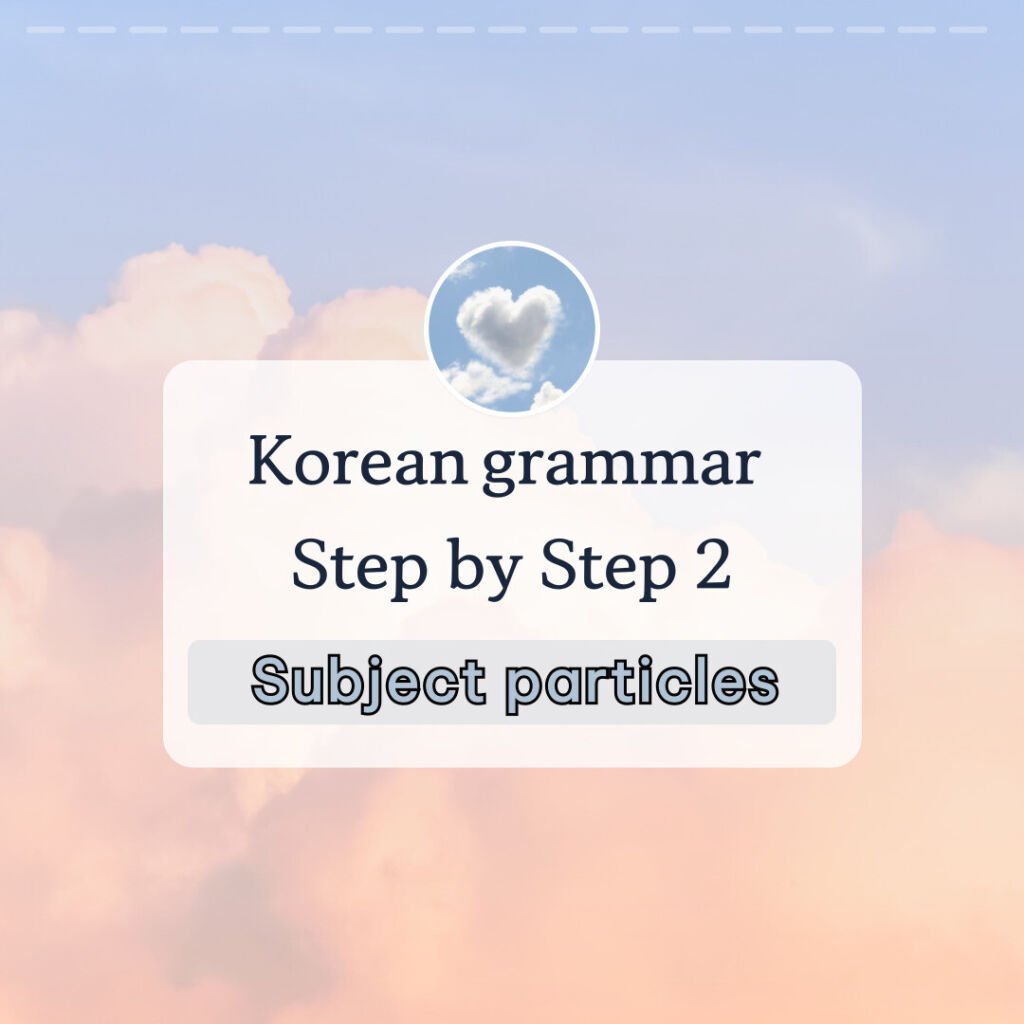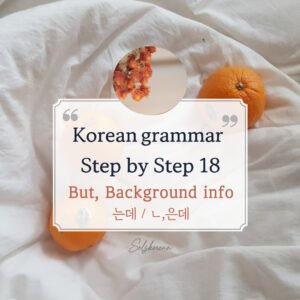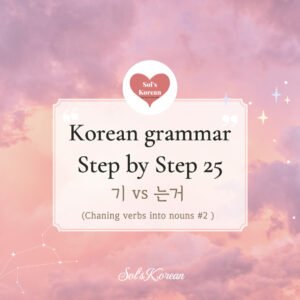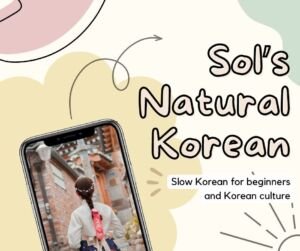Master Subject Particles 은/는/이/가
Hello, welcome to our second step of your Korean journey!
Today, We will be studying Subject Particles 은/는/이/가!
In our previous post, we’ve covered how to say “Be verb – 이다 “, right?
Today we will study how to say the subject part, like “I”, “you” and “She” etc.!
Then, let’s begin on your Korean journey!
Part 1,
Let’s grasp the concept of grammar
So, let’s get accustomed to how we can say ‘I,’ ‘she,’ and ‘we’ in Korean first.
| I | 나 (informal) |
| you | 너 (informal) |
| He / She | 그 사람 (means that person) |
| We | 우리 |
We have words to refer to ‘he’ and ‘she,’ which are 그 and 그녀, respectively.
However, in real life, these words are not commonly used and are mostly found in textbooks.
Instead, we use ‘그 사람,’ which translates to ‘that person.’
Now, do you remember the sentence order in Korean?
Verbs and adjectives are always at the end.
But similar to English, we start the sentence with the subject.
So to say ‘I am Tom,’ it would be ‘I Tom am’ in Korean.
Let’s remind, How can we say “It’s Tom”?
It was 톰이에요, (ends with a batchim -> 이에요)
Now to say, You are Tom. We can use “너(you)” and “톰이에요”
“너 톰이에요”
Perfect! Almost there.
In Korean, we have something called an ‘indicator‘ or ‘particle,’ which we use to indicate the subject, object, etc. These particles don’t have any particular meaning; they simply clarify the grammatical role of the word in the sentence. So here, after stating the subject, we will add a subject indicator/particle to clarify the subject.
4 subject particles
| When the Subject ends in a batchim(final consonant) | 은 | 이 |
| When the subject ends in a vowel | 는 | 가 |
So, when the subject ends in a consonant you can use either 은 or 이
When it ends in a vowel, you can use either 는 or 가
There are differences between 은/는 vs 이/가, but they are subtle and can be complicated for beginners. I’ll cover this topic in a different post.
For now, let’s focus on learning all four particles and getting used to how to use them!
Now let’s finish up how to say “You are Tom.”
“너 톰이에요” → 너는 톰이에요 or 너가 톰이에요.
(The subject 너 ends in a vowel, so we can use either 는 or 가)
How about “She is a Student”?
Student is “학생”.
She is “그 사람”.
To say “She is a student”, it will be
그 사람은 학생이에요.
그 사람이 학생이에요.
We use 은/이 because the subject ‘그 사람’ ends in a batchim (ㅁ), and ‘이에요’
because the noun ‘학생’ also ends in a batchim.
Now let’s try “We are friends”
Friend is “친구”. We “우리”.
It will be:
우리는 친구예요.
우리가 친구예요.
We use 는/가 because the subject ‘우리’ ends in a vowel,
and we use ‘예요’ because ‘친구’ also ends in a vowel.
If you want to say I’m a student,
it will be 나는 학생이에요. or
내가 학생이에요.
For ‘I,’ we always use the particle ‘는’ with ‘나’ and the particle ‘가’ with ‘내.’
Both are quite informal.
We say ‘나는’ and ‘내가,’ but not ‘나가’ or ‘내는’ (though some regions might use these forms as dialect)
If you want to be polite, you can use “저” and ” 제”.
I’m a student → 저는 학생이에요. or 제가 학생이에요 (more polite)
(Just like ‘나’ and ‘내’, 저 only goes with ‘는’ and ‘제’ with ‘가’)
Good! Now, let’s learn how to say our nationality.
Korean(as a person) : 한국 사람.
It’s a combination of 한국(country, Korea) + 사람(person).
Mexican : 멕시코 사람.
멕시코 (country, Mexico) + 사람(person).
So to say your nationality, simply say the country name followed by “사람“.
Here are some country names and their corresponding nationalities:
| China | 중국 | Chinese | 중국 사람 |
| America | 미국 | American | 미국 사람 |
| Thailand | 태국 | Thai | 태국 사람 |
| The UK | 영국 | British | 영국 사람 |
| Japan | 일본 | Japanese | 일본 사람 |
| Germany | 독일 | German | 독일 사람 |
| Peru | 페루 | Peruvian | 페루 사람 |
| France | 프랑스 | French | 프랑스사람 |
| Vietnam | 베트남 | Vietnamese | 베트남 사람 |
| Sweden | 스웨덴 | Swedes | 스웨덴 사람 |
Here’s how to say “I’m American”
나는 미국사람이에요.
내가 미국사람이에요.
Frequently, you will hear 미국인 as well. ‘인’ means a person in Chinese characters.
This also applies to other nationalities: 프랑스인, 칠레인, 캐나다인, etc
Let’s sum up!
Subject particles: 은/는 and 이/가
We use particles to indicate which word is the subject of the sentence.
은/이 : Used when the noun ends in a consonant.
는/가: Used when the noun ends in a vowel.
Examples:
- Consonant Ending Subject+ 은 / 이
She is Subin: 그 사람은 수빈이에요 or 그 사람이 수빈이에요.
Explanation: “그 사람” (she) ends in a consonant(ㅁ), so we use “은” or “이”. - Vowel Ending subject + 는/가
We are friends: 우리는 친구예요 or 우리가 친구예요.
Explanation: “우리” (we) ends in a vowel, so we use “는” or “가”.
Time to practice more!
Part 2,
Vocabulary and Exercise
Here is a vocabulary list.
Try to familiarize yourself with these words before moving on to the exercises.
We will use this vocabulary to create more sentences on your own.
| Teacher | 선생님 |
| Student | 학생 |
| Friend | 친구 |
| Doctor | 의사 |
| Mom | 엄마 (informal) /어머니 (formal) |
| my | 내 (informal) / 제 (formal) |
| You | 당신(formal) |
| our / we | 우리 |
| They | 그 사람들 |
| Dad | 아빠 (informal) /아버지 (formal) |
| Family | 가족 |
| Girl | 여자 |
| Guy | 남자 |
| Younger sibling | 동생 |
| Younger sister | 여동생 (from 여자(girl) |
| Younger brother | 남동생 (from 남자(guy)) |
| Company | 회사 |
| Office workers | 회사원 |
| Role model | 롤모델 |
Now, try to translate these into Korean 🙂
- I am Leah(리아)
- I’m a student
- I’m American
- You are my friend
- You are a teacher
- You are my role model
- He is a doctor
- He is Chinese
- She is my mom
- She is my younger sister
- We are a team
- We are friends
- They are Filipinos
- They are my family
- They are office workers
Let’s check the answers together !
I am Leah(리아)
나는 리아예요 / 내가 리아예요. (informal)
저는 리아예요 / 제가 리아예요. (formal)
I’m a student
나는 학생이에요 / 내가 학생이에요. (informal)
저는 학생이에요 / 제가 학생이에요. (formal)
I’m American
나는 미국 사람이에요 / 나는 미국 사람이에요. (informal)
저는 미국 사람이에요 / 제가 미국 사람이에요 (formal)
You can say: 미국인 as well.
You are my friend
너는 내 친구예요 / 너가 내 친구예요 (informal)
당신은 제 친구예요 / 당신이 제 친구예요 (formal)
* “당신” is a formal way to say “you” in Korean, but it’s not commonly used. Korean is a context-based language, and when the subject is clear, we often omit it. This means we frequently do not explicitly specify “I” or “you”. Instead, to address someone formally, we use formal verb conjugations. For instance, we can switch 예요 to 입니다. For example, “제 친구입니다” is a very formal way to say “You are my friend.”
You are a teacher
너는 선생님이에요 / 너가 선생님이에요 (informal)
당신은 선생님이에요 / 당신이 선생님이에요 (formal)
You are my role model
너는 내 롤모델이에요 / 너가 내 롤모델이에요 (informal)
당신은 제 롤모델이에요 / 당신이 제 롤모델이에요 (formal)
He is a doctor
그 사람은 의사예요 / 그 사람이 의사예요 (formal)
걔는 의사예요 / 걔가 의사예요 (informal)
*”걔” is an informal way to refer to any person.
It’s very commonly used but also highly informal, so only use it with close friends.
He is Chinese
그 사람은 중국사람이에요 / 그 사람이 중국인이에요 (formal)
걔는 중국인이에요 / 걔가 중국사람이에요(informal)
* You can use “그 남자” instead of “그 사람” like 그 남자는 중국인이에요!
She is my mom
그 사람은 내 엄마예요 / 그 사람이 내 엄마예요 (informal)
그 사람은 제 어머니예요 / 그 사람이 제 어머니예요 (formal)
* You can use “그 여자 (that girl)” instead of “그 사람”.
* Here’s the thing: in Korea, when referring to family and country, we tend to use “our” instead of “my.”
For instance, instead of saying ‘내 엄마’ (my mom), it’s more common to say ‘우리 엄마’ (our mom). The same goes for ‘my country’; we never say ‘내 나라,’ it’s always ‘우리 나라’ (our country). This even extends to phrases like ‘my wife,’ where we say ‘우리 와이프’ (our wife) ..😂.
She is my younger sister
그 사람은 제 여동생이에요/ 그 사람이 제 여동생이에요.
걔는 우리 여동생이에요 / 걔가 우리 여동생이에요 (informal)
* Here you can use ‘우리’ as well, you will hear both ‘내 여동생’ and ‘우리 여동생’!
We are a team
우리는 팀이에요 / 우리가 팀이에요.
We are friends
우리는 친구예요 / 우리가 친구예요.
* To make it plural, you can add “들“.
친구 : friend. 친구들 : friends.
However, singularity often replaces plurality in Korean.
I typically add ‘들’ only when I want to emphasize the plural form.
That’s why here ⇃”They” is translated as “그 사람들” in Korean.
We add “들” after ‘그 사람’ (the person) to indicate plurality, making it “those people.”
They are Filipinos
그 사람들은 필리핀 사람이에요 / 그 사람들이 필리핀 사람이에요 (formal)
걔들은 필리핀 사람이에요 / 걔들이 필리핀 사람이에요 (informal)
They are my family
그 사람들은 우리 가족이에요 / 그 사람들이 우리 가족이에요. (formal)
* more common to say “우리 가족” than “내 가족”
They are office workers
그 사람들은 회사원이에요 / 그 사람들이 회사원이에요
* “회사” means company, and “회사원” means office worker. Memorize them together! 🙂
* Here, you can say ‘회사원들’, but I’d simply say ‘회사원’!






